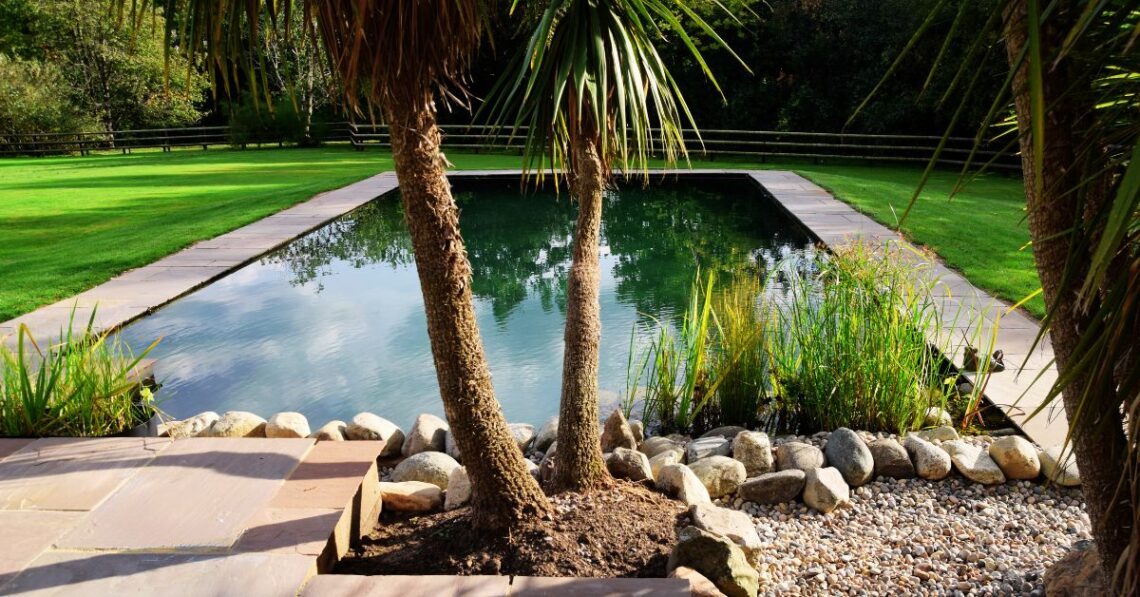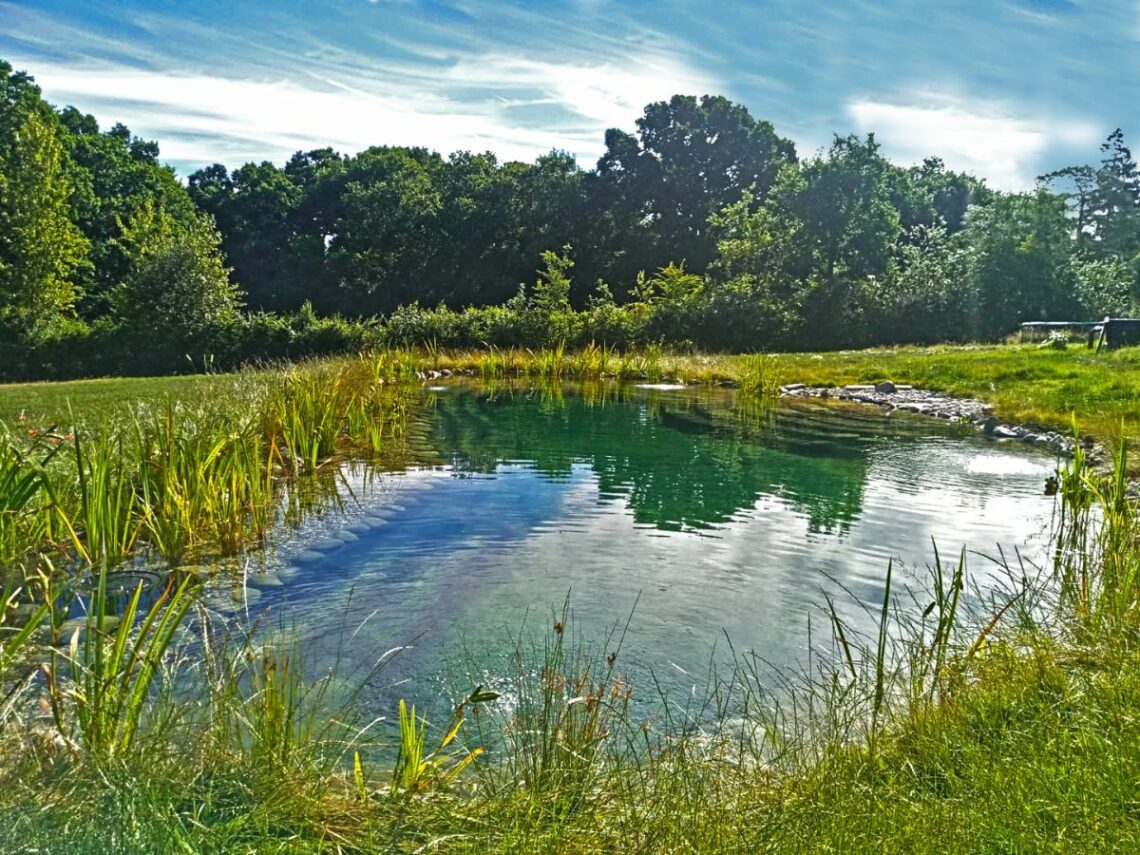1: Planning Your Natural Swimming Pond
Creating a natural swimming pond can be a refreshing and eco-friendly addition to your garden. Unlike traditional swimming pools, these ponds merge seamlessly with the natural landscape, providing a serene and rejuvenating swimming experience. To ensure your swimming pond is not only beautiful but also functional, it’s essential to plan carefully.
In this section, we’ll walk you through the initial steps of designing and constructing your own natural swimming pond.
1.1 Assess Your Space
Before you dive into building your natural swimming pond, assess the available space in your garden. Ensure that the area you choose receives a suitable amount of sunlight, as this is crucial for maintaining water quality and the overall ecosystem. Additionally, consider local regulations and permits, as they might dictate the size and placement of your pond.
When planning the location, think about accessibility and privacy as well. You’ll want a spot that’s easy to reach from your home, but also private enough to enjoy without prying eyes. Unsure about planning permission please see our Ponds by Michael Wheat Planning permission guide.
1.2 Designing Your Pond
The next step is to design your swimming pond. Take inspiration from nature, as these ponds aim to mimic the look and feel of natural bodies of water. You can consult with a professional pond designer or use online design tools to sketch out your ideas – Ponds by Michael Wheat offers a comprehensive Design plan to bring your ideas to reality.
Consider the shape and size of your pond, incorporating curves and irregular edges to create a more natural appearance. You can also include various depths within the pond to cater to different activities, like swimming or aquatic plant growth.
1.3 Filtration System
One of the most critical elements of a natural swimming pond is its filtration system. These systems keep the water clean and safe for swimming while maintaining a thriving ecosystem. An integrated biological filtration system is a hallmark of such ponds. It consists of aquatic plants and beneficial bacteria that naturally purify the water.
For detailed information on filtration systems, check out this resource on swimming pond problems what shows the industry leading way for safe, crystal clear water.
1.4 Choosing the Right Plants
The choice of aquatic plants is crucial for a natural swimming pond. Plants not only contribute to the aesthetics but also aid in water purification. Native water plants, such as water lilies and submerged oxygenators, are excellent choices. They provide shelter for wildlife and enhance the natural appearance of the pond.
1.5 Construction Process
Once your design is finalized and you’ve gathered all the necessary materials, it’s time to start building your natural swimming pond. This is a complex process that requires careful planning and skilled labour.
When building your pond, make sure you incorporate a gentle slope or beach area for easy access in and out of the water. This is especially important if you have children or elderly individuals who will be using the pond.
1.6 Safety Measures
Safety should always be a top priority when creating a natural swimming pond. Electric’s should be a considerable distance away from the swimming pond. Other safety measures are centred around entry and exits from the Swimming Pond so hand rails for steps etc. The water should be safe and algae free if you have the correct filtration system in place however this could be a concern if you don’t.
1.7 Aesthetic Finishing Touches
To enhance the beauty of your swimming pond, add some finishing touches. You can use stones, pebbles, or even a wooden deck around the pond to create a seamless transition from the garden to the water. These elements not only add to the visual appeal but also improve the overall experience.
With your natural swimming pond designed and constructed, you’re well on your way to having a stunning, eco-friendly oasis in your garden. In the next section, we’ll explore the importance of water quality and maintenance to ensure your pond remains crystal clear and inviting.

2: Maintaining Water Quality
Ensuring the water in your natural swimming pond stays clear and safe is a crucial part of pond ownership. In this section, we’ll explore the essential aspects of water quality maintenance and the factors that can affect it.
2.1 Water Circulation
Adequate water circulation is vital for maintaining water quality. Consider installing a pond pump and aerator to keep the water moving. This not only prevents stagnation but also helps with oxygenation, which is essential for the health of both your aquatic plants and the swimmers. Proper water circulation also minimizes the risk of algae growth.
2.2 Monitoring Water Chemistry
Regularly test the water in your swimming pond to ensure the right balance of chemicals. The pH level should be around 3.0, and you can use test kits to measure it. Water hardness and alkalinity are also important factors to keep in check to prevent any damage to your pond’s ecosystem.
2.3 Dealing with Algae
Algae can be a common issue in natural swimming ponds, but there are eco-friendly ways to manage it. One of the most effective methods is to introduce aquatic plants that compete with algae for nutrients. Shade from water lilies and other floating plants can also reduce algae growth. Understanding Algae and Blanket weed is essential in stopping the problem. For more information on managing algae visit swimming pond problems.
2.4 Beneficial Bacteria
Beneficial bacteria play a critical role in maintaining water quality. They help break down organic matter, such as leaves and debris, that can accumulate in the pond. Consider adding a biological filter to promote the growth of these beneficial microorganisms. Bad bacteria you will want to discard from your swimming pond and installing Skimmers and UV lightbulbs will make sure your Swimming ponds are safe.
2.5 Regular Cleaning
Periodic maintenance is necessary to keep your swimming pond in top shape. Remove debris, fallen leaves, and any organic matter from the water’s surface. You might also need to trim and prune your aquatic plants to prevent overcrowding.
By maintaining water quality, you’ll ensure that your natural swimming pond remains a safe and inviting place to enjoy a dip. Now, let’s explore the ecological benefits of these ponds in the final section.

3: Ecological Benefits of Natural Swimming Ponds
In this last section, we’ll delve into the ecological advantages of having a natural swimming pond in your garden. These ponds offer more than just a beautiful place to swim; they contribute positively to the environment.
3.1 Biodiversity
Natural swimming ponds create a haven for biodiversity. The presence of aquatic plants, aquatic life and insects fosters a thriving ecosystem. These ponds often attract various species of wildlife, from frogs and toads to dragonflies and birds. It’s like having your own mini wetland right in your backyard.
3.2 Reduced Chemical Usage
Unlike traditional pools, natural swimming ponds require significantly fewer chemicals. The biological filtration system and the interaction of plants and microorganisms keep the water clean and free of harmful pathogens. This is not only better for the environment but also for the health of those using the pond.
3.3 Energy Efficiency
Natural swimming ponds are generally more energy-efficient than conventional swimming pools. There’s less electricity required to power large pumps and filters continuously. The pond’s ecosystem does much of the work naturally with UV lightbulds and pumps completing the heavy work of ensuring a safe, sanitised water.
3.4 Aesthetic Beauty
Besides their ecological benefits, natural swimming ponds are simply stunning to look at. The integration of water and plant life into your garden creates a harmonious and tranquil atmosphere. These ponds can enhance the overall appeal and value of your property.
3.5 Sustainability
Choosing to have a natural swimming pond aligns with sustainable living practices. You reduce your carbon footprint by using fewer chemicals, less energy, and creating a habitat that supports local wildlife. It’s a small but impactful step towards a greener lifestyle.
In conclusion, building a natural swimming pond in your garden is not only a refreshing and enjoyable addition but also an environmentally responsible one. By carefully planning your pond’s design, maintaining water quality, and appreciating its ecological benefits, you can create a stunning oasis that enhances your outdoor space and supports local wildlife. So, take the plunge and start planning your natural swimming pond today.

Frequently Asked Questions (FAQs)
1. Are natural swimming ponds safe for children and pets?
Natural swimming ponds can be safe for children and pets if certain precautions are taken. Installing safety features such as fences or nets can help prevent accidents. Additionally, educating your family about the potential risks and proper pond etiquette is essential. While the water quality in natural swimming ponds is usually better than traditional pools, supervision is still crucial when children and pets are around.
2. Do I need to use chemicals in a natural swimming pond?
Natural swimming ponds rely on a balanced ecosystem, reducing the need for chemicals. However, occasional water testing and adjustments may be required to maintain water quality. Check out how Ponds by Michael Wheat ensure their swimming ponds are safe to swim in.
3. How much does it cost to build a natural swimming pond?
The cost of building a natural swimming pond can vary significantly depending on factors such as the size, location, design complexity. Generally, natural swimming ponds can be more cost-effective in the long run due to reduced maintenance and lower operating costs compared to traditional pools.
4. Can I swim in a natural swimming pond year-round?
Swimming in a natural swimming pond is typically a warm-weather activity. The water may not be comfortable during colder months, as the pond relies on natural heating from the sun. During the months May – Sept you can experience temperatures between 15 – 27 degrees. In the colder month’s you can still use your swimming pond but due to the colder temperatures wetsuit and bobble hat may be required However, there’s so many benefits to cold water swimming.
Swimming ponds can be heated however most client’s decide against this because temperatures will only ever reach 27 degrees of which is commonly achieved when the Pond will be most utilised the cost of doing so out-ways the benefit.
5. Can I combine a natural swimming pond with a traditional pool?
Yes, it’s possible to combine a natural swimming pond with a traditional pool if you have the space and budget for it. This allows you to enjoy the best of both worlds, with the aesthetics and ecological benefits of a natural swimming pond and the convenience of a traditional pool for swimming during all seasons.